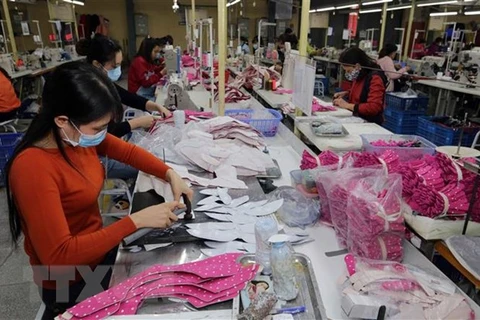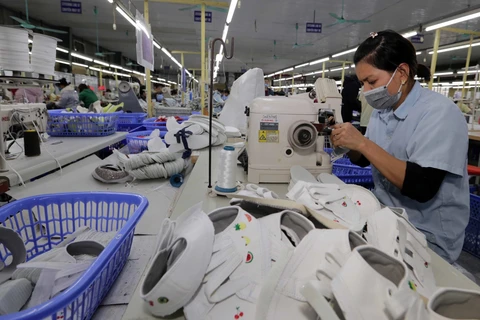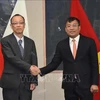Hanoi (VNA) – Vietnam’s import-export turnover is likely to surpass 500 billion USD in 2019 despite declining demand in the world market, heard a regular press conference hosted by the Ministry of Industry and Trade in Hanoi on December 12.
 Deputy Minister of Industry and Trade Do Thang Hai speaks at the press conference (Photo: VietnamPlus)
Deputy Minister of Industry and Trade Do Thang Hai speaks at the press conference (Photo: VietnamPlus) 2019 will be the fourth consecutive year Vietnam enjoys trade surplus at a high level, said Deputy Minister of Industry and Trade Do Thang Hai.
If Vietnam’s trade surplus hit 2.68 billion USD in 2016 and 2.7 billion USD in 2017, and 7.58 billion USD last year, the 2019 figure can exceed 9 billion USD, he noted.
The country’s total trade in January-November was estimated at 472 billion USD, he noted.
In the 11-month period, Vietnam exported 241.7 billion USD worth of goods, a year-on-year rise of 7.9 percent. The country spent 230.7 billion USD on imports, up 6.6 percent from the same period last year.
In the 11-month period, 32 commodities recorded export revenue of over 1 billion USD, of which five had export turnover exceeding 5 billion USD.
The domestic business sector continued to be a bright spot with a growth of 18.1 percent, doubling the national average and five times higher than that of the FDI sector.
Hai said these outcomes were achieved in the context of sluggish global economy due to increasing risks, challenges, and trade protectionism.
Despites difficulties in 2019, the Vietnamese Government and ministries have spared no effort to simplify administrative and investment procedures, said Nguyen Cam Trang, deputy head of the Import-Export Department under the Ministry of Industry and Trade (MoIT).
The MoIT has stepped up the door-opening for Vietnam’s exports through the negotiation and signing of trade agreements to increase the country’s trade turnover, he said.
To date, Vietnam has joined negotiation and signing of 16 free trade agreements (FTAs), with 12 already signed and coming into force, she said.
The Government and the MoIT have paid special attention to the implementation of the Comprehensive and Progressive Agreement for Trans-Pacific Partnership (CPTPP), and the dissemination of information on other FTAs, including the EU-Vietnam Free Trade Agreement (EVFTA), she added.
In addition, Vietnamese businesses have made the best use of opportunities brought by free trade agreements. Total export revenue of goods enjoying C/O incentives accounted for 38 percent of total shipments to FTA partner markets. Especially, some new markets in the Comprehensive and Progressive Agreement for Trans-Pacific Partnership have seen good growth right after the deal came into force, such as Canada and Mexico.
According to Deputy Minister Hai, the Government has closely directed the amendment of regulations relating to trade, customs, the national one-stop shop mechanism, specialized inspection and trade facilitation.
Besides, logistics infrastructure has been significantly improved, with transport works and facilities for goods delivery serving import and export activities being upgraded. In addition, expressways, airports, wharves and logistics centres have been built and expanded, contributing to improving the capacity of loading goods and making goods circulation smooth.
The capacity of Vietnam’s logistics service providers has also much improved, making active contributions to economic activities.
Vietnam was ranked 39th among the 160 surveyed countries in the Logistics Performance Index (LPI) in 2018, up 25 places compared to two years ago, rising to the third position in the Association of Southeast Asian Nations (ASEAN).
Import and export activities in 2020 will face many difficulties and challenges, Hai said, stressing that his ministry will actively employ measures to realise the National Assembly’s set target of 7-8 percent growth in export turnover in 2019.
Last year, Vietnam’s import-export value topped 480 billion USD, up 11 percent from a year earlier. Of the figure, exports hit 243.5 billion USD, up 13.2 percent./.





















